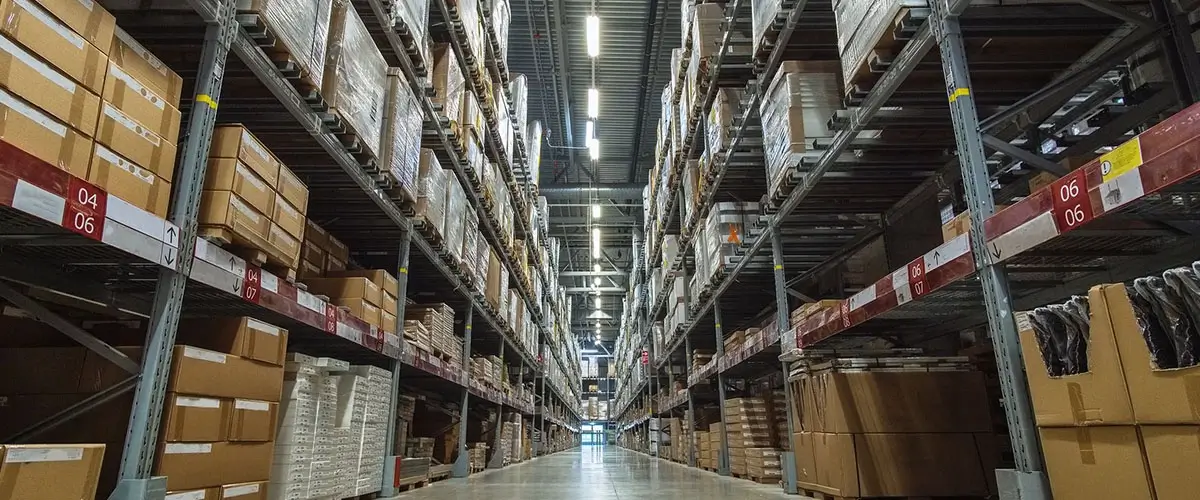Key Takeaways:
- Warehouse locations, or addresses, are essential components for a successful warehouse software implementation, ensuring easy access to inventory.
- Location codes typically consist of three main elements: Sector, Column (bay), and Level, which can be a combination of numbers, letters, or both.
- Proper labeling of warehouse locations is crucial for efficient stock management, ensuring items are easily locatable and reducing errors.
- The article provides a downloadable Warehouse Location Code Generator, allowing businesses to create unique location codes seamlessly.
- Adapting to changing fulfillment requirements is made easier with flexible Warehouse Management Systems (WMS) like Logiwa.
Warehouse Locations Guide (Location Code Generator)
Locations or addresses are one of the main components of a successful warehouse software implementation. Locations categorize physical processes and provide easy access to inventory in your warehouse. The locations should be very clear to operators when they see the location codes on the mobile devices or paper tickets.
BONUS: Before you read further, download our Warehouse Location Code Generator to create your own unique warehouse location codes in seconds.
How to Name Your Inventory Locations
While there is no perfect naming system for warehouse locations, I will share a simple methodology that we use at Logiwa for small business retail warehouses.
Location codes consist of three fundamental elements:
- Sector
- Column (bay)
- Level (some warehouses have only one level of inventory)
Sector, column, and level codes can be made out of numbers, letters or both. In the case of both, your letter A would stand for first level and B for second level, and so on so forth.
The letter and number combination is most commonly used on defining sector codes. For example A-1 or B-02 ; where initial letter shows a zone, an aisle, a street or a block, followed by the number that indicates shows the row or line number.
You can apply below steps to start your naming process:
- Warehouse: If you have more than one warehouses, then a code referring the warehouse must be added preferably as an initial to the location code.
- Section Code: Define your sections according to your warehouse layout (Read: Optimize Your Warehouse Design)
- Inbound staging area: I suggest using a simple numeric character for your inbound staging area. In our sample warehouse layout, the naming formula for inbound staging area can be “Section-Sequential number”. Eg. A-1.
- Outbound shipment area: Similar to the inbound staging area, the naming formula for outbound staging area can be “Section-Sequential number”. Eg. A-2.
- Back-to-back racks: Back-to-back racks need more attention. It is better to define aisles, levels and columns for back-to-back racks.
- I used “Section-Aisle-Column-Direction-Level” naming formula in my small warehouse.
- Eg. B-1-1-L-1 (Section B, Aisle 1, Column 1, Left side, Level 1), B-1-1-R-1 (Section B, Aisle 1, Column 1, Right side, side, Level 1)
- Free areas: In our sample warehouse design, the naming formula for the free areas can be “Section-Sequential number”. Eg. C-1 and C-2
- Value added services : The naming formula for the value added services area can be “Section-Sequential number”. Eg. E-1.
- Packing desks: The naming formula for the value added services area can be “Section-Sequential number”. Eg. D-1,D-2,D-3.
- Damaged product area: The naming formula for the value added services area can be “Section-Sequential number”. Eg. F-1.
- Moving Locations ; If you have locations that move (totes, carts or racks on wheels or other), you should use a name that identifies the function of that location.
- For example if you have cooling racks for baked goods you may want to call them “COOL-1” or “COOL-2”.
- Or you may just use a name that identifies the look of the cart for instance if you have red cart you might call “FERRARI-1” rather than using sector, column, level combination which might confuse pickers as they try to make sense out of that combination.
Location Labels: Why Do We Need It?
In order to have an effective inventory management in your warehouse Every physical location needs to be separated by clear lines in your warehouse and every physical location needs to have a location label with a matching location code available on Inventory Management System.
Inventory items needs to be located quickly for an efficient stock management process therefore items should be located in a way that leaves no question to which location. Location codes must be designed in a way that makes navigating in the warehouse effortless and smooth.
Printing and Mounting Labels Checklist
Here are some guidelines you should follow when printing and mounting your own labels:
- Make sure to have a label printer and matching labels ready:
- Thermal transfer printers require ribbons and must be printed on the colored ribbon installed to normal label papers.
- Direct thermal printers only print in black and only on thermal label paper.
- Shelf labels should be white for maximum contrast to special color coding and arrows.
- If there are no shelf systems available in your warehouse and the inventory is being kept on the ground:
- All locations must be separated from all sides by clear lines
- Location labels can be mounted on a cartoon sheet or a plate right above the location attached to a cable or a simple rope.
- In this case, a letter sized paper is preferred to print the codes on. This way it is it easy for people to read and can be scanned with a barcode.
- Make sure that labels show the full name of the location and no two labels should be the same.
- Labels should be mounted so as not to obstruct normal activity or get easily ripped off or damaged.
- Before applying the label, make sure that the surface is clean. If you have any doubts about whether or not the label will stick over the long-term, cover the label with clear packing tape.
- If you are trying to apply a label to a wire rack, use the duct tape on one side of the wire so that the sticky side of the label and the sticky side of the duct tape will stick together with the wires in between.
- If you need to use arrows, print a sheet of arrows using a word processor and then cut and tape the arrows on either side of your labels.
- When location codes of two different levels are mounted on the same place between shelves an arrow stating the direction that location code belongs to can also be added to the label.
Utalizing Warehouse Location Systems
In the realm of warehousing, an efficient warehouse location system is paramount for streamlined operations and inventory management. As the industry evolves, having a robust system that can easily categorize and access inventory becomes indispensable. Logiwa WMS not only offers a comprehensive solution for warehouse location tracking but also integrates advanced features tailored to modern warehousing needs. Don’t let inventory challenges slow you down; discover how Logiwa WMS can elevate your warehouse location system to new heights.
FAQs: Warehouse Location Systems
Q: What is the significance of a warehouse location system in inventory management?
A: A warehouse location system is vital for efficient inventory management as it ensures easy access to inventory, reduces errors, and streamlines warehouse operations by clearly defining where each item is stored.
Q: How are location codes in a warehouse location system typically structured?
A: In a warehouse location system, location codes usually consist of three main elements: Sector, Column (or bay), and Level. These elements can be a combination of numbers, letters, or both, providing a unique identifier for each inventory location.
Q: Why is proper labeling crucial in a warehouse location system?
A: Proper labeling in a warehouse location system ensures that items are easily locatable, reduces the chances of picking errors, and enhances the overall efficiency of stock management.
Q: Are there tools available to help generate unique location codes for a warehouse?
A: Yes, the article provides a downloadable Warehouse Location Code Generator, which allows businesses to create unique location codes seamlessly, enhancing the efficiency of their warehouse location system.
Q: How can a Warehouse Management System (WMS) like Logiwa enhance a warehouse location system?
A: Logiwa WMS offers advanced features tailored to modern warehousing needs, ensuring that the warehouse location system is flexible and adaptable to changing fulfillment requirements. It integrates seamlessly with location tracking tools, providing a comprehensive solution for efficient inventory management.
Adjust quickly to ever-changing fulfillment requirements with the most flexible WMS.
Warehouse Management
Modern digital WMS powers a modern fulfillment experience






